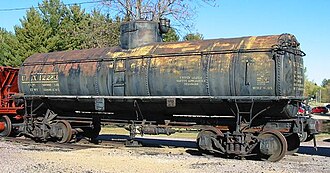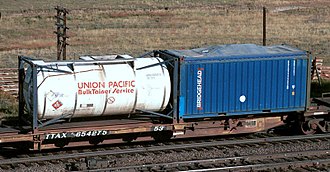AY Honors/Model Railroad/Answer Key

A tank car is a piece of railroad rolling stock designed to carry liquefied loads, petroleum products, liquid chemicals and gasses. Many variants exist due to the wide variety of liquids and gases that can be transported. Tank cars can be insulated or non-insulated, pressurized or non-pressurized, and designed for single or multiple loads. Non-pressurized cars have plumbing at the bottom for unloading, and may have an access port and a dome, housing various valving on the top. Pressurized cars have a pressure plate, with all valving, and a protective cylindrical housing (dome) at the top. Loading and unloading are done through this opening.
Within the rail industry, tank cars are grouped by their interior linings and not by the cargo carried. Food service tank cars are lined with stainless steel, glass or cleanable plastic and they are marked as non-pressurized, insulated cars. Usually these are small and carry around 10,000 gallons. Petroleum carrying tank cars are lined with alloy steel, rubber or carbon steel. They are insulated, usually non-pressurized cars (however, very light petrochemicals or jet fuel cars will be pressurized with nitrogen to prevent evaporation to avoid an explosion hazard). These cars are larger, around 23,000 gallons. the ends will be doubled to prevent ruptures during accidents. As of 2007, the multicargo type mentioned above is obsolete. Natural gas, LPG or ammonia carrying cars are basically 60,000 gallon alloy steel pressure vessels on steel wheels. They have no linings, and are double ended. The whale belly type is giving way to higher but standard width cars.
All tank cars are inspected periodically for damage and corrosion. Relief valves and mounts are inspected at every loading. Pressurized cars are pressure tested regularly to insure they are solid. All tank cars operating in North America now feature "double shelf" couplers that will not uncouple in an accident, so the coupler will not puncture other tank cars.
Insulated cars (which may also incorporate heating or refrigeration systems) are used when the contents must be kept at a certain temperature. For example, the Linde tank car depicted below carries liquefied argon. Cars designed for multiple loads have internal bulkheads to separate the contents. Each compartment must have separate plumbing and its own dome if so equipped. The added complexity of multiple-load cars means that they make up a small percentage of the tank car population. If two loads must be transported, it is often simpler to use two tank cars instead of a two-load car.
In the United Kingdom, Ireland, and New Zealand, tank cars are generally called tank wagons or tanker wagons.
History
- RR-1331.jpg
The narrow domes on these East Tennessee and Western North Carolina Railroad tank cars mirror the designs of the first all-steel units.
- OP-16236.jpg
Texaco, Inc. (TCX) #723, a single-dome tank car designed for transporting gasoline, passes through Amarillo, Texas on April 4, 1936.
- OP-16233.jpg
This double-dome tank car has two separate interior tanks, which allow different products to be transported in the same car.
- OP-19582.jpg
This unusual three-dome tank car has an oversized center dome.
Tank cars have always been specialized pieces of equipment. The interior of the car is usually lined with a material to isolate the car's structure from the contents, such as glass. Loading a liquid into a car that is designed to carry something else is unwise and sometimes dangerous. Even after a thorough cleaning, traces of the previous contents may remain, potentially contaminating the next load. Also, loading a tank car with something it is not designed to carry may actually damage the car, for example if the contents are corrosive.
As a result of this specialization, tank cars have always been "one-way" cars. Other cars, like boxcars can easily be reloaded with other goods for the return trip. Combinations of the two types were attempted, such as boxcars with fluid tanks slung beneath the floors. While the car could certainly carry a load both directions, the limited size of the tanks made this style unsuccessful.
Because of their one-way nature, tank cars are simply dead weight half of the time, making them unappealing to major railroads. A large percentage of tank cars are owned by companies serviced by railroads instead of the railroads themselves. This can be verified by examining the reporting marks on the cars. These marks invariably end in X, meaning that the owner is not a common carrier.
To understand tank car history we need to go to the first tank built, which was in Pennsylvania to move petroleum. It consisted of three open vats bolted to a flat car. The problem came as tank car design and liquid cargo types expanded. Investing in new cars all the time made tank cars unappealing to railways, so a new company was founded: Union Tank Car Company. this company was charged with building, maintaining and running, on behalf of the railways, the tank car fleet.
Timeline
- 1865: Flats with banded wooden tanks mounted on top are employed for the first time to transport crude oil from the fields of Pennsylvania.
- 1869: Cast iron tanks (with an approximate capacity of 3,500 gallons / 13,200 l per car) replace wooden tanks.
- 1888: Tank car manufacturers sell units directly to the oil companies, with capacities ranging from 6,000 gallons to 10,000 gallons (22,700 l to 37,800 l).
- 1903: Tank car companies develop construction safety standards; more than 10,000 tank cars are in operation.
- 1915: A classification system is developed by the tank car industry to ensure the correct match of product being shipped to car type. Some 50,000 tank cars are in use.
- 1920: Welding technology replaces riveting in tank car construction, enhancing the safety of cars.
- 1930: 140,000 tank cars transport some 103 commodities (in addition to oil) to market.
- 1940s: Virtually every tank car is engaged in oil transport in support of the war effort.
- 1950: Pipelines and tanker trucks begin to compete for liquid transport business.
- 1963: The Union Tank Car Company (UTLX) introduces the "Whale Belly" tank car.
Specialized applications
Gas transport
Milk cars

A milk car is a specialized type of tank car designed to carry raw milk between farms or regional creameries and processing plants. Not all milk cars were tank cars. Today, milk would be chilled before loading, and moved in a glass lined, food service tank car.
Pickle cars
A pickle car is a specialized type of tank car designed to carry pickles. This car has four visible wooden tanks and is roofed. Pickles which are preserved in salt brine are loaded through hatches in the roof. Obsolete in 2007
Tanktainers
A tanktainer, also known as a tank container, is a specialized type of container designed to carry bulk liquids or dangerous goods on standard intermodal equipment. The tank is held within a box-shaped frame the same size and shape as a container.
Vinegar cars
A vinegar car is a specialized type of tank car designed to transport vinegar. The largest such car built was built by Morrison Railway Supply Corporation in 1968. The car's underframe included all of the modern conveniences of freight car design including roller bearing trucks and cushioning devices built by FreightMaster, while the tank that rode on it, made of Douglas fir, could hold 17,100 gallons (64,730 liters). The car, called the largest wooden tank car ever built, took 18 months to complete construction. Obsolete in 2007- vinegar now moved in ordinary tank cars lined with glass, plastic, or alloy steel.&
"Whale Belly" cars
In the early 1960s, the Union Tank Car Company (UTLX) introduced a series of "whale belly" tank cars which offered increased capacity over the standard cars of the day. Capable of carrying 33,000 gallons (125,000 l) (for example CSOX #31084) to as much as 63,000 gallons (238,500 l) in the case of GATX #96500, which had been conceived as a 'rolling experiment' of sorts. The largest tank car ever placed into regular service, UTLX #83699, was rated at 50,000 (189,200 l) gallons, and is now on display at the Galveston Railroad Museum -- first hit the rails in 1963 and remained in service for over twenty years. This behemoth is 89 feet (27 m) in length and weighs 175,000 lb. (79,400 kg) empty; the car, which rides on four two-axle trucks to distribute the additional weight, was used to transport such diverse substances as liquefied petroleum gas (LPG) and anhydrous ammonia.
References
- Herron, J. (April 2002). "History Of The Rail Tank Car". e-Train, the online magazine of the Train Collectors Association. http://tcaetrain.org/articles/tickets/tankcar/index.html. Retrieved April 20 2007.
- White, Jr., John H. (1993). The American Railroad Freight Car. The Johns Hopkins University Press, Baltimore, Maryland. ISBN 0-8018-5236-6.


